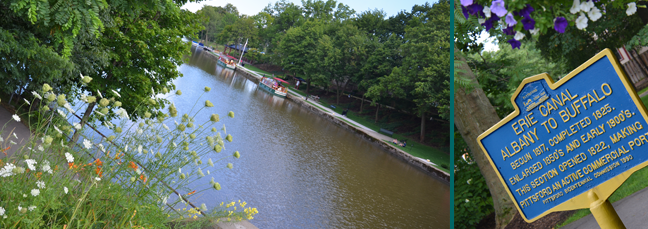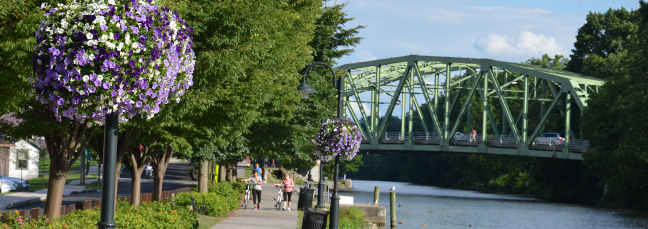The Tale of the Erie Canal
Rewritten by Phillip Martin
Yes, I
know I usually find a folk tale for this section. But that
just isn't available in many parts of the good ole USA.
However, the story of the Erie Canal totally amazed me, and I hope
it does the same for you.
The only thing I knew about the Erie Canal prior to crossing it every day in Rochester was the song that I learned in grade school. "I've got a mule, her name is Sal. Fifteen years on the Erie Canal." Actually, I didn't even remember that correctly. I thought the lyrics sang "sixteen miles". Anyway, that's all I remembered about the song and all I knew about the canal. So, I thought it was time to dig in a little deeper.
I was so surprised when my research began. Some writers claimed the Erie Canal was just as important in American history as the Louisiana Purchase. Now, I remember who bought the Louisiana Purchase, from whom, and when the deal took place. That information was well pounded into my skull in elementary school. But, again, I didn't know anything about this canal, and I have no idea why it didn't get the same treatment as Louisiana.
As with many great projects, you need a man of vision to get the ball rolling or the mules pulling. And in this case, that visionary was Clinton (DeWitt this time, not Bill). In the late 1700's, the Western Inland Lock Navigation Company tried and failed to create a canal that would cross New York to Lake Erie. In the early 1800's, many people of both business and politics declared it was time to dig in, get their hands dirty, (or perhaps the hands of thousands of immigrants and local workers), and make that canal. DeWitt Clinton lead this charge.
Clinton, the former mayor of New York City, campaigned and won the race for governor on a pro-canal platform in 1817. And, as a rare politician who kept to his promises, ground was broken for the Erie Canal near Rome, New York, in July of that year. The ten year plan was to connect Albany on the Hudson River to the struggling outpost Buffalo on Lake Erie. Goods and passengers would flow to and from the Great Lakes to New York City. Probably nobody, even Clinton, fully understood what it would take to dig by hand the 363 mile of canals as well as construct 83 locks, 18 aqueducts, and more than 300 bridges. And for absolute certainty, nobody could predict the impact.

The "Big
Ditch" was 40 feet wide and 4 feet deep. The plan was for
horses and mules to pull canal boats up and down the river at a whopping
four miles per hour. Clinton's vision was to build the canal in
ten years at a cost of seven million dollars. Not everyone was
thrilled about following a visionary, and he almost lost the next
election in 1821. Perhaps some of them were the canal diggers who
earned just eighty cents a day? But, the canal was completed in
1825. It took seven years to complete (well within the ten year plan)
and it came in on budget. (This could be an argument for more
Clintons in politics.)
The impact of the Eric Canal was immediate, even before completion of the project. In 1817, western New York State was considered a wilderness. There were few towns and a very small population. As the canal pushed westward, new towns sprung up along the waterway. Opportunities in business, industry, and agriculture took place at both ends of the canal (Lake Erie and New York City) and everywhere in between.
When the canal was completed in 1825, Clinton took a two week party cruise along the canal. Buffalo, the final destination of the route, quickly changed from a small trading post into a western boomtown. You could call it the "Big Push" or "Manifest Destiny" but the first people emigrating into the Northwest Territory by way of the canal arrived three days after the first boat arrived in Buffalo. And, the flood of people going west was only beginning as the Erie Canal replaced the Cumberland Gap as the entrance to the west.
The population of Ohio, already a state in 1803, doubled in five years after the opening of the canal. The flood of settlers from around the world entered the new states and territories of Illinois, Indiana, Wisconsin, Minnesota, Michigan, and beyond. Many stayed in the Northwest Territory, but many more moved on to the Louisiana Territory. If you were a Native American with reservations about "Manifest Destiny", there were a lot more reservations to come.
The benefits of the canal went both ways, and in the other direction of the waterway from Buffalo stood New York City. (Actually, the canal stopped at the Hudson River, and then NYC was at the base of the Hudson.) Prior to the canal, Philadelphia was the nation's economic powerhouse and New York City competed with Baltimore and Boston, as well as New Orleans and Montreal (Canada), to be the principal port for the nation and the Atlantic coast. Everything was about to change in New York, New York.
The Erie Canal became the most important freight route to and from the East and the Northwest Territory. The route was so successful that it paid for itself in a mere ten years. Growth in New York State and New York City exploded. New York City became the leading port of the nation. It was not only the hub of commerce and industry, but it also was the first stop for many immigrants headed for the Erie Canal and further west. And, as the city grew, so did the financial credit and banking opportunities on Wall Street. New York City established itself as the financial capital of the nation. It is suggested by some that George Washington might have first coined the phrase "the Empire State" to describe New York. The Erie Canal certainly sealed that deal.
Prior to the Erie Canal, most agricultural products from the Northwest Territory traveled down the Mississippi River to New Orleans. Because the canal changed the direction of goods, it had economic and political consequences. The Northwest Territory and the East were linked while the South became more isolated. This bond played a significant role in preserving the Union during the Civil War because their mutual dependence generated a sense of national unity. If the Erie Canal did not exist, it is likely the states in the Northwest Territory would have allied with the South because of their mutual agricultural ties and exports down the Mississippi River.
The end of the Erie Canal era was on the horizon the very same year it was completed. In 1825, the first commercial steam railway started up operations in England. By the 1830's railway transportation made its presence in New York. Originally, the railroads in New York ran alongside the canal to supplement the canal. But, as train transportation improved, they eventually replaced the canal. However, by that time, New York City had already established itself as the nation's port of favor and the most important commercial center. There was no turning back for the Empire State.
The impact of the Eric Canal was immediate, even before completion of the project. In 1817, western New York State was considered a wilderness. There were few towns and a very small population. As the canal pushed westward, new towns sprung up along the waterway. Opportunities in business, industry, and agriculture took place at both ends of the canal (Lake Erie and New York City) and everywhere in between.
When the canal was completed in 1825, Clinton took a two week party cruise along the canal. Buffalo, the final destination of the route, quickly changed from a small trading post into a western boomtown. You could call it the "Big Push" or "Manifest Destiny" but the first people emigrating into the Northwest Territory by way of the canal arrived three days after the first boat arrived in Buffalo. And, the flood of people going west was only beginning as the Erie Canal replaced the Cumberland Gap as the entrance to the west.
The population of Ohio, already a state in 1803, doubled in five years after the opening of the canal. The flood of settlers from around the world entered the new states and territories of Illinois, Indiana, Wisconsin, Minnesota, Michigan, and beyond. Many stayed in the Northwest Territory, but many more moved on to the Louisiana Territory. If you were a Native American with reservations about "Manifest Destiny", there were a lot more reservations to come.
The benefits of the canal went both ways, and in the other direction of the waterway from Buffalo stood New York City. (Actually, the canal stopped at the Hudson River, and then NYC was at the base of the Hudson.) Prior to the canal, Philadelphia was the nation's economic powerhouse and New York City competed with Baltimore and Boston, as well as New Orleans and Montreal (Canada), to be the principal port for the nation and the Atlantic coast. Everything was about to change in New York, New York.
The Erie Canal became the most important freight route to and from the East and the Northwest Territory. The route was so successful that it paid for itself in a mere ten years. Growth in New York State and New York City exploded. New York City became the leading port of the nation. It was not only the hub of commerce and industry, but it also was the first stop for many immigrants headed for the Erie Canal and further west. And, as the city grew, so did the financial credit and banking opportunities on Wall Street. New York City established itself as the financial capital of the nation. It is suggested by some that George Washington might have first coined the phrase "the Empire State" to describe New York. The Erie Canal certainly sealed that deal.
Prior to the Erie Canal, most agricultural products from the Northwest Territory traveled down the Mississippi River to New Orleans. Because the canal changed the direction of goods, it had economic and political consequences. The Northwest Territory and the East were linked while the South became more isolated. This bond played a significant role in preserving the Union during the Civil War because their mutual dependence generated a sense of national unity. If the Erie Canal did not exist, it is likely the states in the Northwest Territory would have allied with the South because of their mutual agricultural ties and exports down the Mississippi River.
The end of the Erie Canal era was on the horizon the very same year it was completed. In 1825, the first commercial steam railway started up operations in England. By the 1830's railway transportation made its presence in New York. Originally, the railroads in New York ran alongside the canal to supplement the canal. But, as train transportation improved, they eventually replaced the canal. However, by that time, New York City had already established itself as the nation's port of favor and the most important commercial center. There was no turning back for the Empire State.

Fortunately, don't think that the Erie Canal is dried up, useless, and stagnant. People still take their boats out on the canal. Certain points along the water are "destinations". Near where I stayed, the lock at Pittsford was simply beautiful. Ducks and kayaks were on the water while the edge of the canal was lined with benches and flowers. And, just beyond those flowers were cafés and boutiques with a view of the waterfront. The Canal still brings a positive impact to the people of New York.
